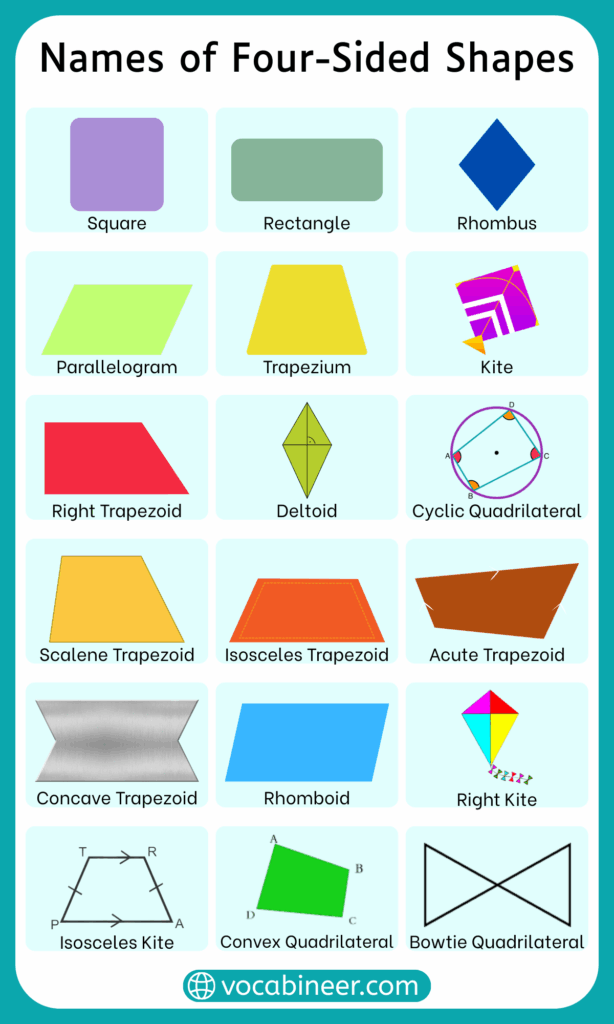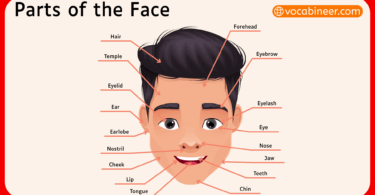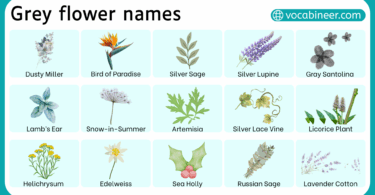Learning four sided shapes names with their pictures helps children understand quadrilaterals in a clear and structured way. These shapes always have four straight sides, four angles, and a name based on their properties. Squares, rectangles, trapezoids, rhombuses, and other types are all included in this group. In this article, you will study these names step by step, useful in school math, art, and describing everyday objects.
In This Page
What Is a Four-Sided Shape Called
A four-sided shape is called a quadrilateral. The word comes from “quadri,” meaning four, and “lateral,” meaning side. Quadrilaterals are some of the most common shapes studied in geometry. They are seen in windows, books, doors, floor tiles, signs, and even road designs.
Names of Four-Sided Shapes
Each quadrilateral has its own name, based on side lengths and angles. Below is a list with short descriptions and examples.
- Square: A quadrilateral with four equal sides and four right angles. It is one of the most regular shapes.
- Rectangle: A quadrilateral with opposite sides equal and all angles right. It appears often in books, doors, and screens.
- Rhombus (Diamond): A quadrilateral with four equal sides but no right angles. It looks like a tilted square or diamond.
- Parallelogram: A quadrilateral with opposite sides parallel and equal. Its opposite angles are also equal, making it balanced.
- Trapezoid (Trapezium): A quadrilateral with exactly one pair of parallel sides. It can be isosceles, scalene, or right-angled.
- Isosceles Trapezoid: A trapezoid with one pair of parallel sides and the other pair equal in length. Symmetry makes it special.
- Right Trapezoid: A trapezoid with at least two right angles. It combines parallel sides with perpendicular height for measurements.
- Scalene Trapezoid: A trapezoid with no equal sides. It still has one pair of parallel sides but no other balance.
- Kite: A quadrilateral with two pairs of equal adjacent sides. It looks like the toy kite used in flying.
- Dart (Concave Kite): A quadrilateral shaped like an arrowhead. It has two equal adjacent sides but bends inward.
- Irregular Quadrilateral: A four-sided shape with no equal sides and no parallel sides. It has no fixed form.
- Deltoid: Another name for a kite-shaped quadrilateral, often used in geometry to describe symmetry in two equal sides.
- Trapezium (UK usage): In British English, trapezium means a four-sided shape with no parallel sides, unlike the U.S. definition.

Properties of Four-Sided Shapes
Quadrilaterals always share three basic rules. They have four sides, four vertices, and four angles. The sum of interior angles is always 360°, no matter the type. Some quadrilaterals, like squares, have equal sides, while others, like trapezoids, have only one pair of parallel sides.
Area of Four-Sided Shapes
The method for finding area depends on the type of quadrilateral.
- Square: Area = side × side
- Rectangle: Area = length × width
- Parallelogram: Area = base × height
- Trapezoid: Area = ½ × (sum of parallel sides) × height
- Rhombus: Area = ½ × (product of diagonals)
- Irregular Quadrilateral: Divide into two triangles by drawing a diagonal. Find the area of each triangle and add them.
Quick Area Formulas Table
| Shape | Formula | Example Use |
|---|---|---|
| Square | side × side | Tile, box, board |
| Rectangle | length × width | Books, doors, screens |
| Rhombus | ½ × diagonal₁ × diagonal₂ | Playing cards, road signs |
| Parallelogram | base × height | Patterns, tiling |
| Trapezoid | ½ × (a + b) × height | Bridges, ramps |
| Kite | ½ × diagonal₁ × diagonal₂ | Glass windows, toys |
| Irregular | Split into triangles | Land plots, uneven designs |
Comparison Chart of Four-Sided Shapes
| Shape | Sides & Angles | Examples in Life |
|---|---|---|
| Square | Four equal sides, four right angles | Tiles, boards, floors |
| Rectangle | Opposite sides equal, four right angles | Windows, books, doors |
| Rhombus | Four equal sides, opposite angles equal | Card diamonds, traffic signs |
| Parallelogram | Opposite sides parallel and equal | Logos, flooring, art |
| Trapezoid | One pair of parallel sides | Roof beams, ramps |
| Kite | Two pairs of equal adjacent sides | Flying kites, glass panels |
| Irregular Quadrilateral | Unequal sides, no parallel lines | Land plots, designs |
Four-Sided Shapes in Daily Life
Quadrilaterals appear everywhere. Squares are seen in board games and tiles. Rectangles are in notebooks, screens, and doors. Trapezoids shape ramps, bridges, and roof supports. Rhombuses, also called diamonds, mark road signs. Irregular quadrilaterals often appear in land boundaries and creative architecture. Recognizing these connections helps beginners remember their names.
2D vs 3D Four-Sided Shapes
Quadrilaterals are flat 2D shapes. Some learners confuse them with 3D solids. A tetrahedron, for example, is a pyramid with four triangular faces, not a four-sided polygon. Quadrilaterals always stay on a flat surface, while 3D shapes extend into space.
FAQs About Four-Sided Shapes
Four-sided shapes are called quadrilaterals. The name includes squares, rectangles, trapezoids, rhombuses, kites, and irregular quadrilaterals.
A single four-sided shape is also called a quadrilateral. This term applies to any polygon with exactly four sides and four corners.
A square always has four equal sides and four equal angles. A rhombus also has four equal sides, but its angles are not right angles.
Both the square and the rhombus have four congruent sides. The difference is that squares have right angles, while rhombuses do not.
Every quadrilateral has a total of 360° inside. This is true for squares, rectangles, trapezoids, kites, and all irregular four-sided shapes.
A trapezoid (called trapezium in some regions) has exactly one pair of parallel sides. It is used in ramps, bridges, and roofs.
An irregular quadrilateral has no parallel sides. These shapes appear in land plots, irregular designs, and custom floor tiling.
A square has four equal sides and four equal right angles. It is the most regular and symmetric quadrilateral.
Read More




